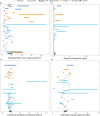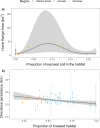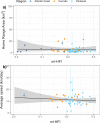Movement ecology of vulnerable lowland tapirs between areas of varying human disturbance
- PMID: 35287742
- PMCID: PMC8919628
- DOI: 10.1186/s40462-022-00313-w
Movement ecology of vulnerable lowland tapirs between areas of varying human disturbance
Abstract
Background: Animal movement is a key ecological process that is tightly coupled to local environmental conditions. While agriculture, urbanisation, and transportation infrastructure are critical to human socio-economic improvement, these have spurred substantial changes in animal movement across the globe with potential impacts on fitness and survival. Notably, however, human disturbance can have differential effects across species, and responses to human activities are thus largely taxa and context specific. As human disturbance is only expected to worsen over the next decade it is critical to better understand how species respond to human disturbance in order to develop effective, case-specific conservation strategies.
Methods: Here, we use an extensive telemetry dataset collected over 22 years to fill a critical knowledge gap in the movement ecology of lowland tapirs (Tapirus terrestris) across areas of varying human disturbance within three biomes in southern Brazil: the Pantanal, Cerrado, and Atlantic Forest.
Results: From these data we found that the mean home range size across all monitored tapirs was 8.31 km2 (95% CI 6.53-10.42), with no evidence that home range sizes differed between sexes nor age groups. Interestingly, although the Atlantic Forest, Cerrado, and Pantanal vary substantially in habitat composition, levels of human disturbance, and tapir population densities, we found that lowland tapir movement behaviour and space use were consistent across all three biomes. Human disturbance also had no detectable effect on lowland tapir movement. Lowland tapirs living in the most altered habitats we monitored exhibited movement behaviour that was comparable to that of tapirs living in a near pristine environment.
Conclusions: Contrary to our expectations, although we observed individual variability in lowland tapir space use and movement, human impacts on the landscape also had no measurable effect on their movement. Lowland tapir movement behaviour thus appears to exhibit very little phenotypic plasticity in response to human disturbance. Crucially, the lack of any detectable response to anthropogenic disturbance suggests that human modified habitats risk being ecological traps for tapirs and this information should be factored into conservation actions and species management aimed towards protecting lowland tapir populations.
Keywords: Anthropocene; Continuous-time movement modelling; Home range; Human Footprint Index; Space use.
© 2022. The Author(s).
Conflict of interest statement
The authors declare that they have no competing interests.
Figures






References
-
- Abra FD, da Costa CA, Garbino GST, Medici EP. Use of unfenced highway underpasses by lowland tapirs and other medium and large mammals in central-western Brazil. Perspect Ecol Conserv. 2020;18:247–256. doi: 10.1016/j.pecon.2020.10.006. - DOI
-
- Allen AM, Singh NJ. Linking movement ecology with wildlife management and conservation. Front Ecol Evol. 2016 doi: 10.3389/fevo.2015.00155. - DOI
-
- Barnosky AD, Kraatz BP. The role of climatic change in the evolution of mammals. Bioscience. 2007 doi: 10.1641/B570615. - DOI
Grants and funding
LinkOut - more resources
Full Text Sources
Research Materials
Miscellaneous

